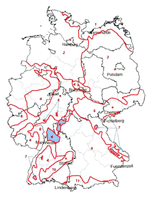 The higher the insulation level of a building component is the less heat is available for its drying. As a consequence of the better airtightness of the building envelope, in addition the indoor air humidity increases. Both together require also higher demands on the moisture protection of the building components. This is increasingly verified by means of a hygrothermal simulations like WUFI®. These methods need appropriate indoor and outdoor climate data. To close the existing gaps, as part of a research project the following topics were investigated
The higher the insulation level of a building component is the less heat is available for its drying. As a consequence of the better airtightness of the building envelope, in addition the indoor air humidity increases. Both together require also higher demands on the moisture protection of the building components. This is increasingly verified by means of a hygrothermal simulations like WUFI®. These methods need appropriate indoor and outdoor climate data. To close the existing gaps, as part of a research project the following topics were investigated
- Hygrothermal reference years for Germany
- Local climate models to adapt regional climate data to local conditions
- Indoor climate of unused adjacent rooms like cellars, crawl spaces, attics and stairways
- Effective heat transfer coefficients for ventilated roofs, cover layers, reveals, corners and edges etc.
The new models allow for an easier, and in addition, more reliable design of the moisture safety in new buildings and in case of renovations and will be successively implemented to the different programs of the WUFI®-family.
Already online available, there is the guideline for „Hygrothermal Simulation of ventilated pitched roofs with effective transfer parameters“. The hygrothemal reference years and the local climate model will be provided with the next updates of WUFI Pro 6.1.
The research report “Klima- und Oberflächenübergangsbedingungen für die hygrothermische Bauteilsimulation” (ambient climate models and surface transfer coefficients for the hygrothermal simulation) is available only in German language.